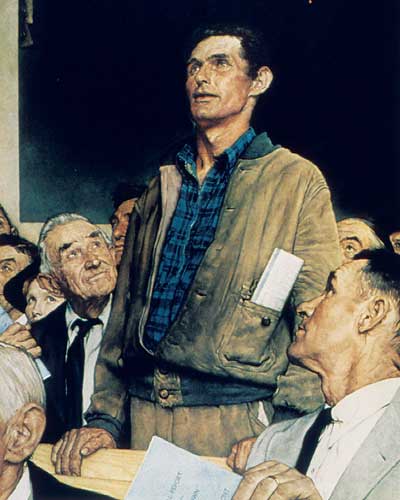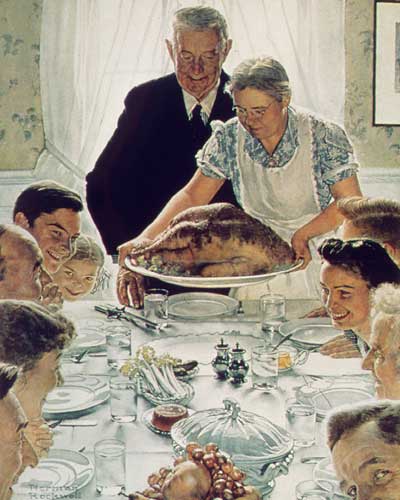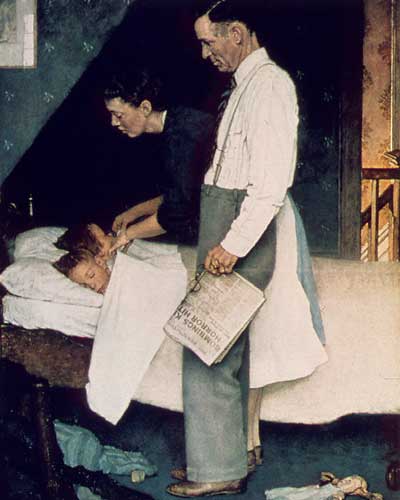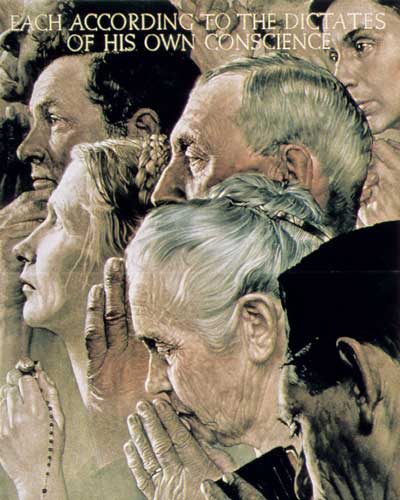In his 1941 annual message to Congress, Franklin D. Roosevelt spoke of a future founded on “four essential human freedoms”: freedom of speech, freedom of worship, freedom from want, and freedom from fear. A year later, after the United States entered World War II, artist Norman Rockwell began to translate the Four Freedoms into “simple, everyday scenes” for The Saturday Evening Post, which published them in February and March 1943. Sales of posters of the paintings raised $132 million in war bonds.

freedom of speech(1) Rockwell often said that the inspiration for the series was a town meeting in Arlington, Vermont, where he had witnessed a resident protesting a popular plan to build a new school. (2) Rockwell biographer Deborah Solomon found this scene unconvincing: in addition to the “near absence of women,” she notes, “it seems unlikely that the established banker types would be trying to glean wisdom from an ordinary worker.” (3) When the painting appeared in The Saturday Evening Post in February 1943, it was accompanied by a short story by Booth Tarkington in which the young Adolf Hitler and Benito Mussolini meet in 1912 and discuss how dictators must destroy freedom of speech. |

freedom from want(1) “Freedom from Want was not very popular overseas,” Rockwell recalled in his 1960 memoir. “The Europeans sort of resented it because it wasn’t freedom from want, it was overabundance, the table was so loaded down with food.” (2) The Saturday Evening Post asked the Filipino American novelist and poet Carlos Bulosan to write a text to accompany this painting. He described “forces which have been trying to falsify American history” and “drive many Americans to a corner of compromise with those who would distort the ideals of men that died for freedom.” (3) Rockwell later said he never liked this painting or Freedom from Fear because the two had no “wallop.” |

freedom from fear(1) Rockwell received more than sixty thousand letters about the Four Freedoms series. One, from the Pioneer Suspender Company, noted that “the father in Freedom from Fear was wearing a pair of suspenders from Pioneer. He had damn good reason to be free from fear…as long as his pants were being held up by Pioneer.” (2) “I really believed that the war against Hitler would bring the Four Freedoms to everyone,” Rockwell said in 1976, “but I couldn’t paint that today. I just don’t believe in it. I was doing this best-possible-world, Santa-down-the-chimney, lovely-kids-adoring-their-kindly-grandpa sort of thing. And I liked it, but now I’m sick of it.” |

freedom of worship(1) Rockwell grew so frustrated with his first version of the painting, which depicted men of various faiths “laughing and getting on well together” in a barbershop, that he scrapped it and started over. (2) Rose Hoyt, the model for the woman holding rosary beads, was an Episcopalian. Rockwell asked her, “Would you be a Catholic for today?” (3) In 2018 a group of photographers exhibited updated versions of Rockwell’s Four Freedoms, with a cast of models more diverse than Rockwell’s neighbors. “America didn’t look like that then,” artist Hank Willis Thomas said in an interview. “It definitely doesn’t look like that now.” |